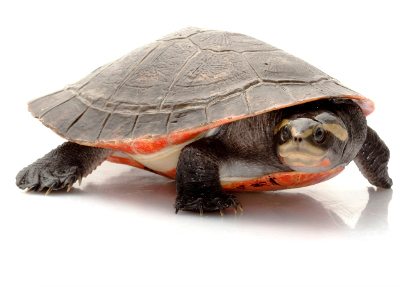Red-bellied Short-necked Turtle
Category: Turtle

Facts about Red-bellied Short-necked Turtles. "Scientific name for Red-bellied Short-necked Turtle is Emydura subglobosa". This is an Emydura type of turtle that belongs to the Chelidae family. The Red-bellied Short-necked Turtle are largely found in Papua New Guinea and Australia, and they are also called as Jardine River turtle. They spend most of their time around shallow, mud-covered regions of water.
Features of Red-bellied Short-necked Turtle
An adult Red-bellied Short-necked Turtle will obtain a maximum body length, ranging from 8 inches to 9 inches (20 to 23 cm). The carapace of this turtle is appealing and it appears with an average to charcoal gray color without any design. The plastron conduit and underside of the secondary scutes of the Red-bellied Short-necked Turtle have an outstanding coral pink and lighter gray design that does not fade as the turtle matures. The head of the Red-bellied Short-necked Turtle is dark gray in color, with a yellow color line behind its eyes, and there is a vivid coral design below the bottom jaw. Usually, the male Red-bellied Short-necked Turtle is smaller than the female turtle, and it has a lengthier tail than the females.
When the Red-bellied Short-necked Turtle is developed in the captive, they are provided with plastic greenery, cork bark or ramps of some type to enable them to come out of the water or to be comforted when they snooze at night.
Diet of Red-bellied Short-necked Turtle
The Red-bellied Short-necked Turtle will feed on lean beef, worms, chicken hearts or livers, Trout Chow and fish. Occasionally, they also feed on banana pieces, a variety of greens, like escarole, Romaine lettuce and slivers of zucchini squash. In the captive, the Red-bellied Short-necked Turtle are fed with a calcium block, made from plaster of Paris combined with water and than dried, this should be in their water all the time.
Behavior of Red-bellied Short-necked Turtle
The Red-bellied Short-necked Turtle is highly aquatic and seldom leaves the pond except to breed. These turtles are inveterate baskers, and will settle on by the hour in the sunlight or below a heat lamp. Outdoors, the Red-bellied Short-necked Turtles are the primary ones sunning in the sunrise, and they are the last ones to go back to the water at sunset. Indoors, they will lie around in the rays of a 75-watt spotlight, but they prefer the natural sunshine. In the captive, the Red-bellied Short-necked Turtles are provided with overhead Vita-light lamp instead of natural sunlight.
Reproduction of Red-bellied Short-necked Turtle
The mating season in Red-bellied Short-necked Turtle varieties starts from February and continues until July. All of the female turtles produce numerous clutches of eggs. The Red-bellied Short-necked Turtle have a peculiar breeding behavior such that they will come upon the land and pace in the lawn for a maximum period of two weeks earlier than finding a breeding spot that best suits them.
The Red-bellied Short-necked Turtles on land once or twice, usually in the early morning or night, and excavate shallow nests quickly, habitually between lawn tussocks that make the location of eggs more difficult to find by their predators. The female turtle will lay 7 to 14 eggs and it covers the nest extremely carelessly, not solidifying the soil by means of her plastron. The Red-bellied Short-necked Turtle eggs are hard-crusted, oval-shaped and generally about a length of an inch (2.5 cm). Usually, the gestation period is 42 to 49 days.
The average lifespan of the Red-bellied Short-necked Turtle ranges from 20 years to 30 years.

 Back To Category Turtle
Back To Category Turtle